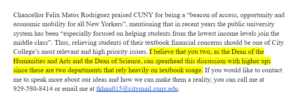In the beginning of the semester, my idea of the audience was very simple and straightforward. I believed that the audience was simply the people we are speaking to in our writing pieces, or the intended group of people we are targeting. My audience suggestions would be very general and overly broad. For example, when thinking about the audience for a political speech, I might say, “the American public”. However, it’s clear that the audience is actually even more specific than that. Although I’ve learned to think critically about the audience in past English classes, Professor Carr truly pushed us to zone in on our exact audiences every assignment by making us complete multiple audience profiles.
When I thought about who our audience was for the first assignment, the Memo, my first assumption was Professor Carr. Soon, through class exercises and discussions, I realized I was being very close minded. The purpose of my Memo was to start a discussion on the issue of costly textbooks and push CCNY to help their students have less expenses. Thus, there were many factors I needed to consider: what authority is in charge of the textbooks? There are several departments in CCNY, which departments have the jurisdiction to take care of this issue? Who else besides my intended target might read this Memo? How should I word this Memo depending on my audience? These were all questions I asked myself. Eventually, I realized that “the Dean of the Arts and Humanities and the Dean of Science can spearhead this discussions with higher ups since these are two departments that rely heavily on textbook usage” (Figure 1). Even now, I realized that I could’ve gone deeper regarding the audience. The Financial Aid Office was a department I could’ve considered, especially because I was advocating for less student expenses.

As the semester progressed, my understanding of the audience continued to develop. For the last assignment, the Engineering Proposal, “Emergency SOS Alarm from Brains Against Natural Disasters”, I had to think about a primary, secondary, and tertiary audience. I considered not only the Director of the U.S National Science Foundation (NSF), Dr. Sethuraman Panchanathan, but the Director of Budget Division at NSF and the Director of an independent funding organization dedicated towards creating innovation to help natural disasters. I learned that I needed to target my audience correctly in order to achieve my purpose. If I write a Memo, or a Technical Description, but aim it at the wrong audience, my purpose will not be accomplished.
For example, for my group’s instruction packet, “How To Create and Operate a Balloon Powered Car”, I had a slight miscommunication with the audience. I thought that the audience was young children, such as elementary schoolers. Thus, I suggested making the instructions more simple and easy to understand so that children with poor reading skills could follow them. However, my peers explained to me that the car was a project aimed at younger teens, and required materials like a hot glue gun and a sharp object, which are not safe for children. Thus, our audience was actually teachers and parents. If I made the instructions catered towards elementary schoolers, I would’ve failed to accomplish my purpose, which is to inform how to build and operate the project, because it’s not possible for younger kids to complete it properly.

